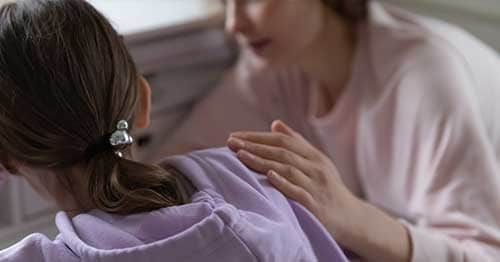6 Ways Online Students Can Socialize Outside of the Classroom
by Phoebe Brown
byKristina Cappetta
6 min to readThe statistics surrounding suicide among children are alarming. It is the second leading cause of death for children ages 10-14 and the third leading cause of death for those ages 15-24. Young people are also engaging in dangerous self-harming patterns, with research showing that 17% of all adolescents admitting to some form of self-harm in their lifetime. As a parent or guardian, it’s important to be aware of what’s causing this type of behavior and the warning signs of suicide so you can help your child.
Take advantage of resources that provide professional help and support groups for teens at risk of suicide and harming themselves. These crisis lines are available 24 hours a day, 7 days a week:
National Suicide Prevention Hotline: Dial 988 or chat at 988lifeline.org
Crisis Text Line: Text Home to 741741
Self-harm is when someone injures themselves on purpose. This can include cutting, burning, or carving the skin. When children do these things, they often don’t intend to die by suicide. But research has shown that more than nine in ten adolescents who have attempted suicide have also reported purposely hurting themselves.
There are several signs that your student may be hurting themselves on purpose, including:
Wounds that won’t heal or get worse
Scabs or scars in a particular shape
Wearing long-sleeved shirts in warm weather
Collecting sharp tools such as scissors, glass, safety pins, etc.
Wearing many bandages without explanation
Isolation from social activities
Depression
While self-harm can occur on any part of the body, the most common areas include arms, wrists, the front of the thighs, and the abdomen.

If you suspect your student is hurting themselves, there are things you can do to help.
Talk to your pediatrician and connect with a mental health professional as soon as possible. Seeking professional help early can help your student learn positive coping mechanisms rather than resorting to self-harm.
Talk to them about what’s going on or what concerns you have. Be honest and be sure to listen and not judge.
While it may be difficult, remove as many hazardous objects as you can such as scissors, razors, and sharp knives. Not having them in plain view or easily accessible is important. Any firearms should always be inaccessible and all medications locked away.

Suicidal ideation, also referred to as suicidal thoughts, is when someone is considering suicide or is preoccupied with thoughts of death. While having suicidal thoughts is different from physically attempting suicide, it can lead to suicidal behaviors and self-harm.
When talking about suicidal ideation, there are two types, passive and active.
Passive suicidal ideation means a person experiences suicidal thoughts but does not have any desire to plan actions of hurting themselves.
Active suicidal ideation is when a person has a plan to hurt themselves and intends to act on it.
Anyone who has suicidal thoughts and has a plan to hurt themselves needs immediate medical help and should not be left alone. Every verbalized threat of suicide should be taken seriously, no matter how often this has been verbalized without action.
Whether your student is experiencing passive or active suicidal ideation, you should still prioritize speaking with a mental health professional as soon as possible.
Statistics show that more than 20% of teens have seriously considered suicide. Kids and teens have a harder time working through emotional problems, which could lead to anxiety and depression—a leading cause of suicide. Kids who attempt suicide report feeling stress, self-doubt, pressure to succeed, disappointment, and loss.
Other factors that sometimes lead to suicide in teens and kids include:
Family history of suicide and mental health issues
Being the victim of abuse, violence, and other forms of trauma
Separation from loved ones due to things like divorce, deployment, and incarceration
Bullying (including cyberbullying)
Discrimination or rejection due to sexual orientation
Loss or rejection from classmates, boyfriends or girlfriends, and others
While some kids show no signs that they are planning to take their own life, others demonstrate behavior or signs that should be taken very seriously. Here are several warning signs of suicide to look for:
If you hear a child talking about wanting to die, take them seriously and seek professional help.
Major changes in eating and sleeping habits are a sign that something is wrong. Teens who are depressed or considering suicide may stop taking care of their personal hygiene—not showering regularly or brushing their hair. They may struggle doing their schoolwork, and their grades could slip.
Teens who are considering suicide may start using drugs and alcohol. The thought that they have nothing to lose may lead them to engage in this and other risky behaviors they normally would not think of doing.
Teens may stop spending time with family and friends and begin to isolate themselves. Depression and feeling as though they are not worthy to spend time with others and have fun can all be warning signs of suicide.
Excessive sadness and crying can both indicate that a teen is in distress. Irritability or yelling out uncontrollably can also be red flags that something is wrong.
Many tweens and teens have keepsakes that are important to them. It’s a red flag when they start giving those things away. They may do this because they know they will no longer need them, or they want those things remembered and protected after they are gone.
If you see questionable social media posts on your teen’s social media accounts, it’s important to get them help. This can be their way of seeking attention for any suicidal thoughts they may be having.
If your child is showing any warning signs of suicide, it is important to act immediately.
Go to the emergency room for an evaluation if you feel as though they are in immediate danger.
Contact their pediatrician, who can recommend a mental health evaluation, as well as healthcare professionals who specialize in treating mental health issues in children. A mental health provider can help your teen create a safety plan that serves as a personalized guide for what to do when they are feeling overwhelmed by suicidal thoughts.
Talk to your teen about their feelings and let them know you are there for them no matter what. Be empathetic and non-judgmental.
The Connections Academy Team has also compiled a Suicide Awareness Resource Sheet that includes other valuable information when it comes to recognizing warning signs of suicide and self-harm in children.
National Suicide Prevention Hotline: Dial 988 or chat at 988lifeline.org
Crisis Text Line: Text Home to 741741
